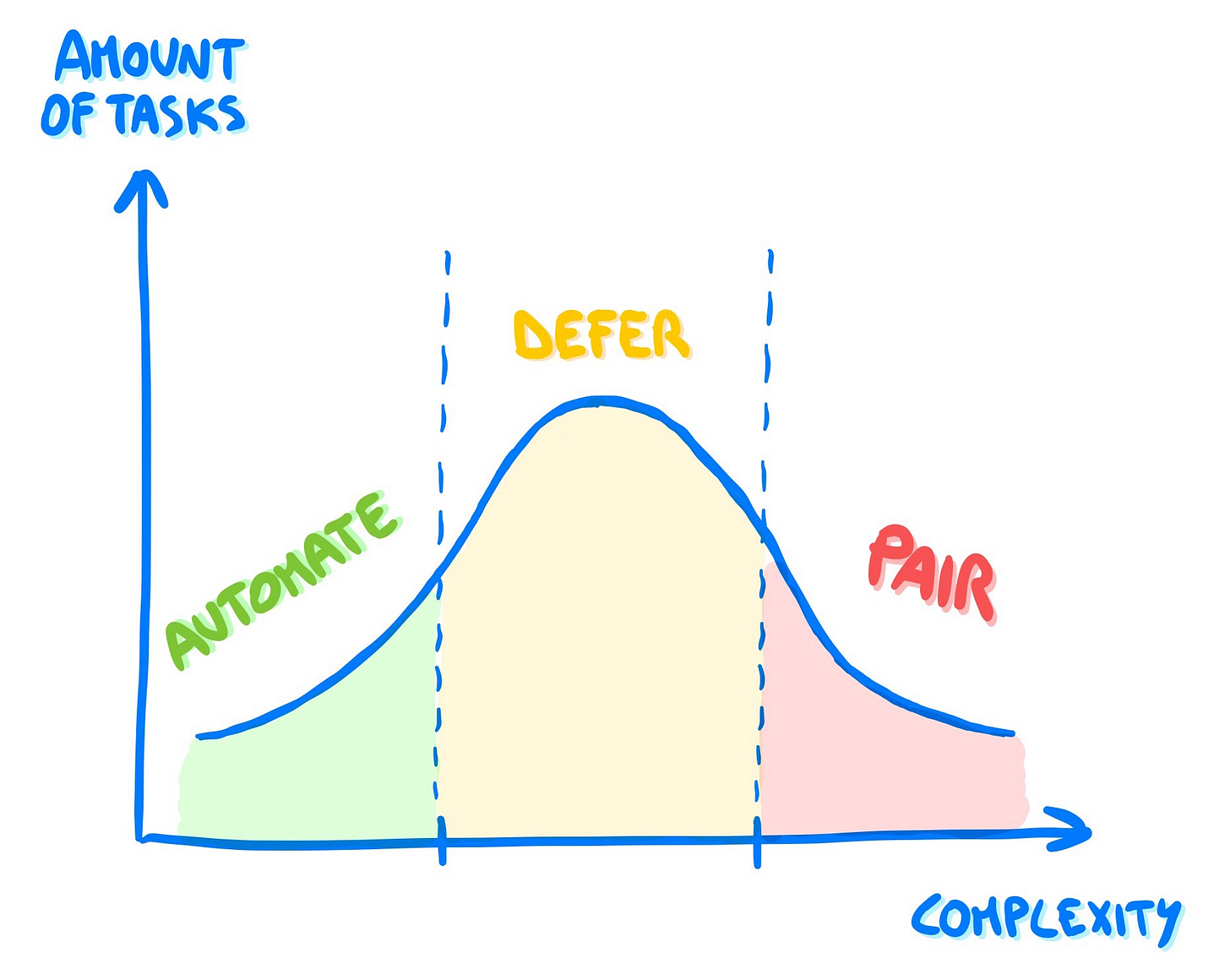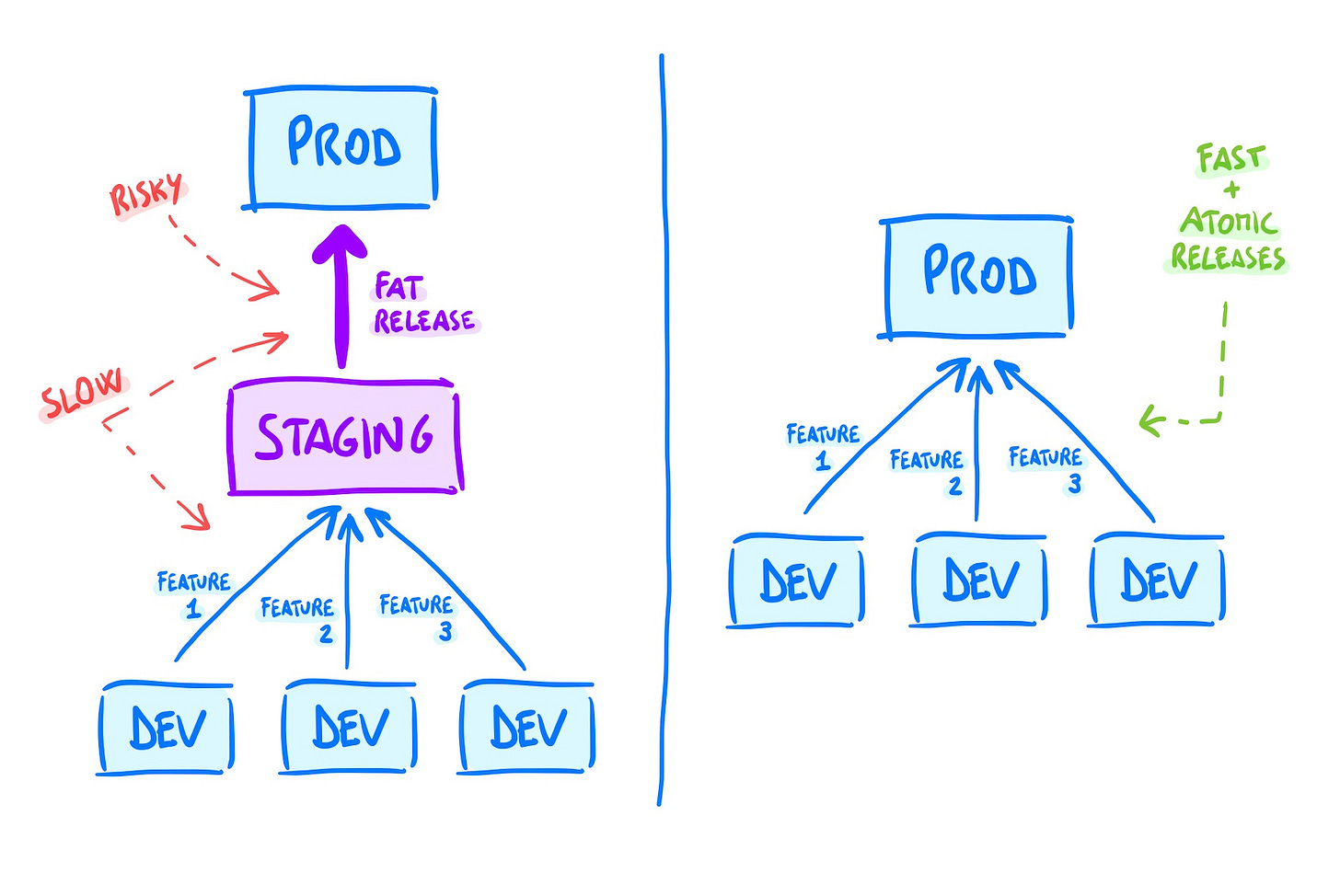Code reviews, the map is not the territory, and making staging optional 💡
Monday Ideas — Edition #116
💬 Unblocked – get the right answer, now
Most AI dev tools today focus on code generation.
In my experience, however, the most time-consuming part of development is not writing code, but getting the right context.
In part that’s because decisions are scattered across multiple tools (GitHub, Slack, Jira, Notion, etc), and the right person isn't always available, which leads to a lot of waiting and wasted time.
For this reason, I am happy this week to promote Unblocked, which connects to all your tools, surfaces this knowledge and gives engineers the answers they need to get their jobs done:
Back to this week’s ideas! 👇
1) 🔍 Are you happy with your code reviews?
Code reviews are a double-edged sword. They're crucial for quality, but can easily turn into big bottlenecks.
Last month I proposed a simple approach, called Automate / Defer / Pair that chooses behavior based on different types of code changes:

Automate simple tasks 🔧
For changes with low knowledge sharing and improvement potential, skip human review. Rely on static analysis and test pipelines instead.
Examples are: fixing small bugs, adding tests, or minor cosmetic changes.
Defer reviews for most routine changes ↪️
Review the majority of code changes, but at a later time — without blocking merging. Why? Because quality improvements and knowledge sharing can happen post-merge.
It works especially well in continuous delivery workflows where you use feature flags to push changes frequently in a disabled state.
Pair for critical and complex changes 👯
When should you opt for real-time collaboration? It’s two scenarios:
🔒 High-stakes changes — when correctness is crucial (e.g., database migrations, payment workflows).
🧩 Complex code — large PRs or intricate algorithms where async reviewers lack context.
Pairing works better in these cases because face time provides high-bandwidth communication, and allows for deeper and faster reviews, without all the async back-and-forth.
You can find the full article with more ideas and the longer explanation below 👇
2) 🗺️ The Map is not the Territory
The Map is Not the Territory is a mental model that emphasizes the difference between our perceptions / models (the map) and the actual reality (the territory).
It reminds us that models are useful, but they are not the reality: their goal is to represent a slice of reality, in a way that is useful for a specific goal.
In other words, they are just tools — if you overstep their boundaries / goal, they may turn useless or even harmful.
This is true for all kinds of models, not just the big, high level frameworks we are covering today. We create models all the time:
Software 💻
When designing software, we model how the system works in the form of diagrams, docs, and even tests.
However, these are not a perfect representation of the actual code.
A diagram could help understand the structure of your codebase, but it may not be exhaustive about dependencies, which makes it insufficient to decide e.g. how to partition the system.
Project management ⏱️
We create plans, roadmaps, and resource estimates, to help us organize and deliver projects.
However, these are not the projects themselves, and we must be prepared to adapt our plans if new information becomes available or unforeseen challenges arise.
Whenever you encounter a hard problem, focus on what you need to accomplish, and figure out what models / frameworks can be helpful.
I covered a wide range of mental models for engineers in this previous article 👇
3) 💣 Don’t remove Staging — make it optional
I know I have some radical views about simplifying release pipelines. For example, I try as much as possible to remove Staging environments and make devs push straight to prod.
Of course this assumes a lot of things: good tests, good instrumentation, breaking down work in small parts, etc.
It’s a journey, but especially when it comes to using Staging, you don’t need to do all or nothing.
Let’s say you analyzed your workflow and figured out that:
A large chunk of changes could go straight to prod, but
There is a 20% of cases where you still need staging
What do you do?
The easiest improvement you can make is to turn staging into an optional step in your release process.
You separate the staging workflow from your main branching strategy, and give developers the agency to choose to either deploy to production or test on staging first, based on risk and complexity.
For many teams, this is 1) easy to do, 2) it builds ownership, and 3) it gets 80% of results with 20% of the effort
Win-win-win! Sometimes, when we design processes, we limit ourselves by thinking that things can only be either always or never.
There are often good solutions in between.
I wrote more ideas about staging environments here 👇
And that’s it for today! If you are finding this newsletter valuable, consider doing any of these:
1) 🔒 Subscribe to the paid version — if you aren’t already, consider becoming a paid subscriber. 1500+ engineers and managers have joined already! Learn more about the benefits of the paid plan here.
2) 🍻 Read with your friends — Refactoring lives thanks to word of mouth. Share the article with your with someone who would like it, and get a free membership through the new referral program.
I wish you a great week! ☀️
Luca






This is really interesting, and I love the idea of flexibility (e.g. make staging optional, have different code review protocols depending on the type of code change). At CodeYam, our team's been thinking a lot about how to make it faster to ship high-quality products. One thing that keeps coming up is that there's the potential for a radically more efficient workflow with software simulation as a means to understand, test, and demo code changes and their resulting product and user impact. Our first functional demo was actually around the example of a pull request review!
I'm always curious to hear how others are thinking about code review, testing, and quality along with the underlying processes and tools.
If curious, you can find the CodeYam PR review demo here: https://blog.codeyam.com/p/video-demo-of-the-codeyam-software